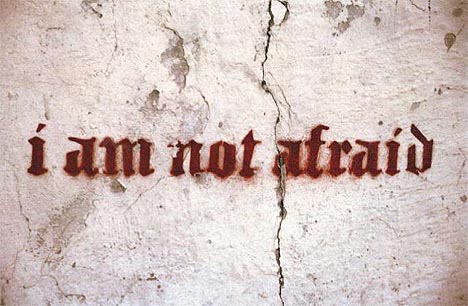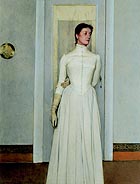
translated and summarized by: Liz Wollner-Grandville,
English summary January 21 - 28
Camera Austria: I am not afraid. The Market Photo Workshop, Johannesburg
100 and still going strong
Recently the 100th edition of the Camera Austria magazine was published. This institution, which considers itself to be a project, celebrated its anniversary by presenting artistic photography in a social-documentary context. The exhibit as well as the publication is focused on the Market Photo Workshop, Johannesburg, which was co-founded in the 80s, in the midst of Apartheid, by David Goldblatt. The intention of the workshop was to offer photographic training to people, who would have otherwise have had a dreary future ahead of them. The graduates of this workshop had the chance to utilize the close contacts made to potential employees - both artistically as well as professionally.
In this display you will see six types of artistic designs and two projects, in which numerous photographers were involved. Zanele Muholi`s portraits "Faces & Phases" (2006/07) are deeply touching; not only through the aesthetics of black and white photography but also through the background stories of the people involved: everyone who has been photographed is a member of the black lesbian community in South Africa and therefore exposed to severe violence. Nontsikelelo Veleko focuses his work on urban neighbourhoods in two different contexts: on graffiti and on people wearing special outfits. Lerato Maduna presents photographs of soccer games as well as the very impressive series "Back and Forth" showing people involved in risky trading transactions at the South African border.
The Camera Austria magazine also functions as a catalogue for the exhibit - it offers explanations on the background of the workshop as well as the deeper meaning and focus of the projects. In his contribution, David Goldblatt thanks the co-founder of Camera Austria, Christine Frisinghelli, for her work, and at the same time clearly expresses his worry concerning the current situation of the state-sponsored workshop, and reminding everyone to stay alert at all times.
Camera Austria
8020 Graz, Kunsthaus Graz, Lendkai 1, until 02.03.08
www.camera-austria.at
Falckenberg Collection: Tomas Schmit - Can people think?
Of mice and chameleons
One example of Tomas Schmit`s witty expressions, which are usually combined with his paintings, is "`at the back` is placed at the beginning of this sentence". At first sight his clever remarks may simply seem amusing, however, oftentimes they turn out to be intellectual explosives. Nam June Paik once announced that he would have loved to trade his oeuvre with Schmit`s thousands of illustrations. He was only 20 years old when he joined the Fluxus movement, later he was George Maciunas assistant and soon after that presented his own work - the "cycle for water buckets" (or bottles). Schmit filled the water from the buckets into the bottles, which were arranged in a circle, until no water was left. But Schmit soon abandoned this kind of absurd theatricality and devoted his time to illustrations.
His inclination towards reduced forms stemmed from the Fluxus movement. These reductions manifested themselves in his delicate, childlike-anarchistic humour as well as his seemingly sketchy paintings. But their content was often times much more complex if not even cryptic and had more to do with horror vacui or laconic text-pictures. With a kind of feigned naiveté Schmit deals with philosophic and scientific questions, but hardly ever demanding a serious answer. In the catalogue, Stefan Ripplinger describes this cheerful dialogue as "art and science cheering to one another, and sometimes not even condemning dirty jokes". Schmit arrived at his individual, aphoristic articulation by way of his illustrations. These disarmingly cheerful works have titles such as "always these ups and downs, thought the carrot" (1975) or "this is how salmonellas imagine a virus" (1995).
In his unconventional picture puzzles for the series "Utopia" (1975) Schmit created numerous paradox diagrams, all meant to say something about "giving", taking" (diagonal shadings) and "being happy" (empty space), the result is a colourful checked pattern: absolutely stunning. Another series is the "square of the circle" (1972) dedicated to being a senseless artistic problem. An especially enchanting experiment is a chameleon contrived as the embodiment of a dialectic ratio towards the environment, and shown by Schmit in the most abstruse constellations.
All this ingenuity contains fantastic puns, questioning the system of language and at the same time being solemnly sceptical - thereby opening an ample scope of thinking, which emerges between the pure creative potential and the contingence. This is also the distant attitude Schmit has towards his own profession. "If someone wants to find out more about art, he can throw away complete libraries, as long as he has read Kafka`s "Josefine, die Sängerin oder das Volk der Mäuse".
Sammlung Falckenberg
21073 Hamburg, Wilstorfer Strasse 71, until 31. 01. 08
BA-CA Kunstforum: The Kiss of the Sphinx - Symbolism in Belgium
"Conceptualize an idea into a sensual format"
We still have difficulties with 19th century art. Only the Impressionists and their immediate ambit are considered as socially accepted and blessed by their followers of the Modernist movement as "formally innovative", while art works created by the academies and salons still carry the as being "almost worthless". Symbolism lies somewhere in between these two ratings - neither fish nor fowl - even if everyone is conscious of its wide-ranging relevance. However, its objective, literary form often inhibits that this knowledge is utilized. Even Kandinsky`s, Kupka`s and Mondrian`s early symbolic works are much less valued than their abstract paintings - although the abstraction, like the Expressionism, can be deviated from Symbolism.
Alongside England and France, Belgium greatly contributed to the abundance of the different symbolist manifestations. Literary symbolism was created both in Belgium as well as France. Fernand Khnopff`s elegant mythological individualism, James Ensor`s biting and discerning Primitivism or Félicien Rops pornographic caricatures are all unique expressions within a subjective, powerful display of the reflective art of the human psyche`s dark sides. In his Symbolist Manifesto (1886) the French poet Jean Moréas, described this as "conceptualizing an idea into a sensual format". One could also call them paintings characterized by the discomfort in a secularized, progress-belief orientated time of upheaval.
The entire affluence of Belgian symbolic painting and graphics is displayed in this exhibit. Among one of the most important paintings displayed is the portrait of Margeurite Khnopff in a white dress, painted by her brother Fernand, the "high mystic from Brussels" (Ludwig Hevesi). The artist idolized and staged this painting for many years. Félicien Rops` blasphemous "Temptation of St. Antonius", showing a beautiful, nude woman crucified and worshiped by the horrified St. Antonius, as well as the graphic "Pornocrates", depicting a half nude demimonde beauty, eyes covered and holding a pig on the lead. George Minne`s dainty boy`s sculpture "Small relic carrier" as well as works by less well-known artists such as Léon Fréderic or Henry de Groux` are also displayed.
BA-CA Kunstforum
1010 Vienna, Freyung 8, until 03.02.08
www.ba-ca-kunstforum.at
Kunstmuseum Stuttgart: In the limelight - Baumeister as a set designer
Punchinello for connoisseurs
With Willi Baumeister`s exhibit of his set designs the Kunstmuseum Stuttgart is reprocessing part of its ample and high-ranking collection. The exhibit succeeds the Kunstmuseum`s meritorious documentation of Oscar Schlemmer`s, Willi Baumeister`s and Franz Krause`s art works, held in May 2007, which were created in the "Laboratorium Lack" (enamel lab) during the Second World War.
Numerous expressive sketches and designs for theatre productions, photos of theatre rehearsals and performances, and film as well as music samples supplement the exhibition and make it entertaining for families. In addition the museum has published a highly commendable catalogue - wonderfully detailed as well as carefully and accurately researched. This is proof of how well museums can utilize their potential to undertake scientific research as well as put together attractive exhibitions.
Many new aspects can be discovered at this show: Among them Baumeister`s early experimental theatre productions in Stuttgart during the 20s. They were created in the spirit of the early Bauhaus movement with dominant primary colours (like Schlemmer) and nearly Dadaistic furore as well as the "Kasperl-Spiele für große Leute" (Punchinello for adults). This was Baumeister`s last stage design created in 1953, many years after the "Raumskizzen" (room sketches) which he produced during the national socialist "Arbeitsverbot" (work prohibition).
Kunstmuseum Stuttgart
70173 Stuttgart, Kleiner Schlossplatz 1, until 10. 02. 08
www.kunstmuseum-stuttgart.de
Mehr Texte von translated and summarized by: Liz Wollner-Grandville


 Teilen
Teilen




